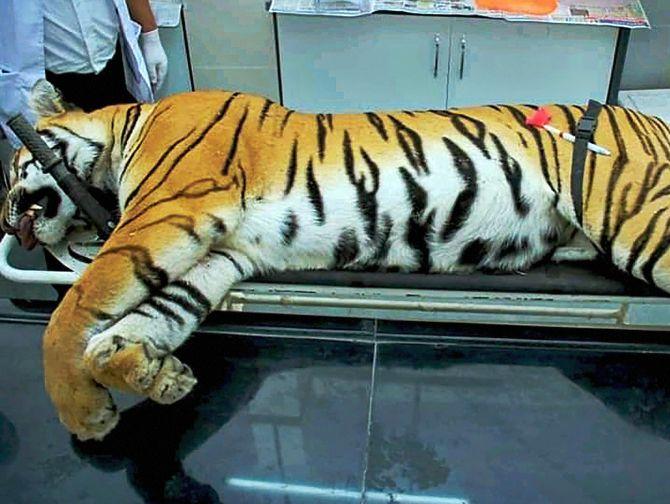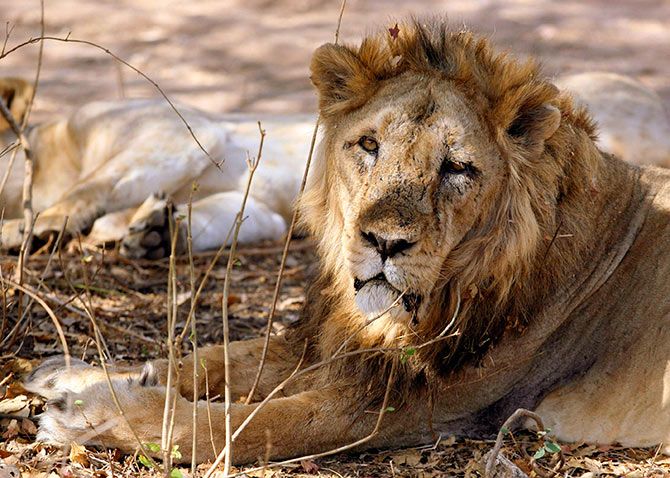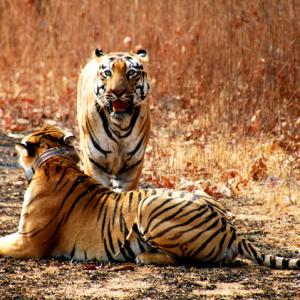'Animal populations are increasing. Human populations are increasing. So there is no way the man-animal conflict going to go away.'

She strayed into a village on the fringes of this riverine jungle reserve and was rescued by forest workers after being stoned and badly beaten by villagers, said forest officials. Photograph: Parth Sanyal/Reuters
Dr Mayukh Chatterjee was in his office in Delhi when he heard that tigress Avni had been shot in Pandharkawada forest, Yavatmal, Maharashtra.
He didn't feel shock. More dismay. Dismay that the death could have been easily avoided but had come to pass.
"I was disheartened. This particular case had seemingly set a wrong precedent: That any tiger that attacks human beings can be deemed a man-eater, without putting much thought into under what circumstances the attacks had occurred," Dr Chatterjee tells Rediff.com's Vaihayasi Pande Daniel.
Dr Chatterjee heads the Wildlife Trust of India's human-wildlife conflict mitigation division and has been working for the organisation for the last seven years. The Wildlife Trust of India is an animal wildlife NGO working to conserve wildlife since 1998.
Dr Chatterjee, who has a PhD in animal behavioural ecology from the National Institute of Advanced Studies, Bengaluru, works on strategies to tackle animal-man discord.

The case of Avni was a prime example of the kind of discord that increasingly is being seen within or on the periphery of India's forests as big cat populations grow instead of being depleted as are human populations.
Such conflicts are only bound to rise as the tiger population increases. On Monday, December 2, 2019, Environment, Forest and Climate Change Minister Prakash Javadekar told the Rajya Sabha that the tiger population in the country has increased by 750 in the last four years to 2,976. Earlier, the country's tiger count was 2,226, the minister said.

"Drones," he says, "are very helpful in searching over expanses of crop fields, as well as to check out locations remotely without putting ourselves in harm's way." Photograph: Kind courtesy Dr Mayukh Chatterjee.
The killing of Avni brought a lot of attention to the subject of wildlife-human conflict. Tigers probably take a large share of the story. In some ways, it is good because it brings people's attention to the topic that another smaller animal may not.
But as someone who works with man-animal conflicts, what is your perspective on Avni? Was she actually a man-eater?
It is hard to say regarding Avni in particular, because there are two sides to the story.
One side talks about her general elusive behaviour, because of which the department concluded that she was a man-eater.
Of course, there were 13 or 14 kills assigned to her, of which (for) two it was concluded that she was the one who killed the last two victims. One (of the kills) they asserted based on DNA evidence.
But, in general, apart from the kills, the way she was eluding the people, who were trying to capture or track her, led the department to think she was a man-eater.
Of course, there was a huge amount of political pressure as well.
But the other side of the story is that the people who were actually monitoring that area felt that the kills, that were ascribed to her, were pretty far apart.
There were gaps of somewhere of the order of 50 days or 60 days between the human deaths. The logic goes that a tiger with cubs is not going to stay hungry for 50 days or 60 days. So she must have been killing other things as well, either livestock or natural prey.
So it is a little hard to assert whether she was a man-eater or not.
I also feel that had the tranquilising teams been given enough time and support -- like the shooting teams were provided -- Avni could have been successfully tranquilised, well before she had taken out her last two victims.
It is essential to understand that a large proportion of tigers in India occur in territorial forest (beyond wildlife reserves) which are also extensively used by local communities for their livelihood needs.
Many a time females with cubs also occupy these forests, and due to the presence of cubs, are tremendously defensive, and therefore will not shy away from taking out an intruding human.
Traditionally, a man-eater is described as an animal who actively hunts down humans, who actually seeks humans as food.
Generally if you read stories of Jim Corbett or Kenneth Anderson (both Indian-born British writers and game hunters. Corbett was a conservationist too), or even other historical accounts, these animals (man-eaters) are invalid.
They cannot hunt fleet-footed animals like deer. Either they have a broken canine or a dislocated jaw or dislocated limb or have porcupine quills embedded somewhere. These are the animals that take to hunting humans because humans are easy prey.
That distinction is often very difficult to make in the field. Until you capture the animal, you don't know if the animal is impaired or not. That's why it is imperative that every attack situation is analysed in depth.
Where did the tiger come from?
How many people were there with the victim?
Was the victim alone?
Was the victim squatting?
What time of day and what time of the year did the attack happen?
So once you start analysing each case you can, sort of, in a more concrete way, say if a (certain) tiger could potentially be a man-eater because it seems fearless of humans and is actually seeking humans out.
There have been examples in Uttar Pradesh, for example, where a tiger was at large in a forest patch. It was entering villages at night and pulling out people from their cots. Even when there were crowds of people, there were instances when the tiger faced a larger gathering of people and it charged head on and grabbed a woman.
That kind of desperate, daring attitude actually tells you: 'Okay there is something wrong with this tiger. It seems to be a man-eater and appears to be hunting humans. This animal needs to be eliminated'.
It needs to be removed -- whether by capture, or whether by elimination, that's a different question altogether.

So given that Avni was not showing this kind of behaviour, was her killing premature since they had not been able to pin down conclusively that she was a man-eater?
There is also so much of political pressure. Because it is a tiger. Because it is killing and eating human beings.
There is a huge amount of hue and cry and political turmoil that happens when such cases happen. Definitely in Avni's case it did happen.
If you read the recent NTCA (National Tiger Conservation Authority, the reorganised body that has taken over from Project Tiger) report, the people who shot down Avni themselves say she just walked out. They fired the dart and she just growled.
The earlier talk about her attacking the people on the Gypsy (jeep) was all bullshit. Basically she snarled.
Of course, when you hit a tiger with something it is going to snarl at you.
And she walked off. In a knee-jerk reaction the shooter just shot.

The lions clawed their way back from near extinction and today their population stood at about 600 in the state in March 2018, but lost numbers towards the end of 2018 when they were inflicted with a virus. Photograph: Amit Dave/Reuters
Are there enough checks and balances in place?
Yes, there are not enough checks and balances in place. In fact, what I was talking about analysing every situation -- it is not done anywhere in India.
Some of the places, where the Wildlife Trust of India works mitigating conflicts with big cats, we try to study each case as much as possible.
But in 99% cases, any attack on human beings is not studied at all. Primarily because there is local hue and cry immediately. Then the department is under tremendous pressure to sort of pacify the aggrieved villagers first.
They are not given the time to study it, really?
They are not given the time. They don't have the time at all.
If you see some of these officers they are so harassed by politicians. Within a few hours they will get calls from local MLAs saying you are going to get fired if you don't do this. If you don't pay the compensation and all sorts of things. (That is) ultimately the root cause of the problem... One is the pressure, of course.
The second is the capacity, the pre-emption that when the kill happens to follow a set of protocols. These are the things that we are going to check for. Treating every kill as a crime scene. Cordoning it off. Checking for signs.
Which direction did the tiger attack from? What was the probable position of the victim? Which part was eaten? Monitoring that area to see if the tiger comes back or not.
Those kinds of things are never followed. There is a very low amount of capacity. People are not skilled enough in the department. They are not trained with respect to these (methods).
Firstly, of course, is that when a kill happens there is a huge amount of political pressure and then nobody then thinks about trying to do all those kinds of things (the protocols mentioned above).

When it comes to tigers, lions and panthers, one is quite aware of the current or potential man-animal conflict areas like the Gir National Park or the Vidarbha area in Maharashtra. But if you take into consideration all kinds of animals, which are the worst areas of man-animal conflict?
Well it depends. With respect to elephants, for example, there is a huge amount of conflict in Karnataka. There is a huge amount of conflict in Kerala. There is a lot of conflict in Jharkhand, Odisha.
When it comes to tigers, Sunderbans in West Bengal has the highest number of human deaths because of tigers. Second is Uttar Pradesh -- the Dudhwa-Pilibhit (north east UP) landscape.
And then you have leopards.
If you are talking about human-wildlife conflict it is pretty much there everywhere wherever wildlife species exist. It is about where you would like to draw the line.
For instance, if you consider rodents. Rodents eat crops. If you consider rodents as wildlife there is rodent-human conflict everywhere (rodents, like cockroaches, are useful in maintaining ecological balance in cities and the countryside as scavengers and for breaking down garbage, but also carry disease).
If you want to draw the line for only certain kinds of mammals, then it is pretty much confined to protected areas, wildlife sanctuaries, tiger reserves etc. You have a huge amount of conflict with wild pigs, for instance, in a lot of places. In Maharashtra over the last few years several people have died at the hands of wild pigs.
There is a lot of crop raiding that happens at the hands of elephant, nilgai ( an antelope species called colloquially as blue bull), wild pigs. There is once in a way conflicts with wild gaur (Indian bison).
So you name it and there is conflict. Snow leopards in the Himalayas. There is conflict with brown bears, black bears.
See in any protected area that works towards securing or preserving wildlife populations, the populations are going to boom. None of these areas are fenced off. The very tenets of protected area management and preservation are that they stay within a mosaic landscape of human habitation.
They are like our green parks in the city. Within the green patch -- say any city park -- if you foster the growth of squirrels, for example, you will have conflict. You will have squirrels coming (out of the park) and nesting in houses, in your ventilators.
So it is the same thing with black bears, brown bears, tigers, leopards or elephants. As these populations grow, individuals are going to come out (of the core protected area). This is just inevitable.
Often people talk about: When is conflict going to go down or disappear all together? Or how can it be completely taken care of?
It just cannot be completely taken care of! It is a problem that is going to keep on happening.
Animal populations are increasing. Human populations are increasing. So there is no way is it going to go away.
The only thing that can be done is that you can actually put in a place a very, very effective system of management.
That is where -- the earlier things I was talking about when a kill happens -- there is a set of group calls that a department does. They do it by hook or by crook -- cordoning off the crime, treating the kill site as a crime scene, collecting all the evidence very systematically, getting them analysed systematically.
If it is a man-eater, deciding very concretely that this is a man eater and then putting into effect a very, very strong approach to capture that animal.
If it is not a man-eater, there are alternative ways of managing the situation. Those management measures can be put into place as well.
On the side, there are also long-term measures that can be implemented. Many of our protected areas like the Dudhwa tiger reserve (northwest Uttar Pradesh), for example, actually hail from the British era, where all these forests were turned into timber production yards. Much of them are very systematic plantations, monoculture. Many of these monocultures do not foster enough growth of pastures or grasses, which a lot of herbivores depend upon.
This becomes a cascading effect. So you have a big green patch 80% of which is a monoculture, which has no green pastures. Where are the herbivores going to go? They are going to go outside into the fields of crops.
You can potentially increase more pasture spaces inside. Instead of creating monoculture, you can create indigenous mixed species growth, which creates good habitat for herbivores to stay.
Good herbivore population inside will also keep a lot of carnivores inside. So it is a simple chain link impact approach. These kinds of (efforts) also need to run alongside, apart from the management strategies.
Once these kind of approaches are put into place -- built into the idea-action plan for the forest department and are implemented diligently -- a lot of conflict can be managed very well.
But it is never going to go. It is never going to disappear.










